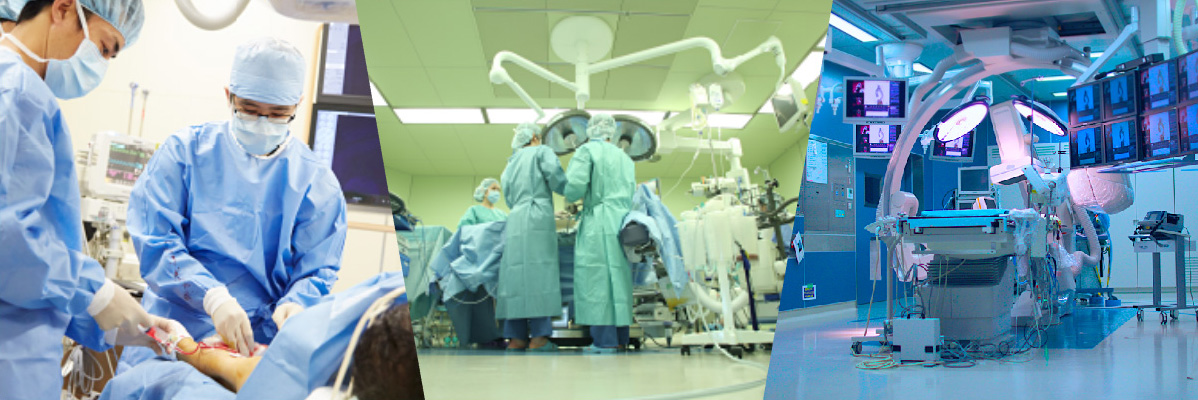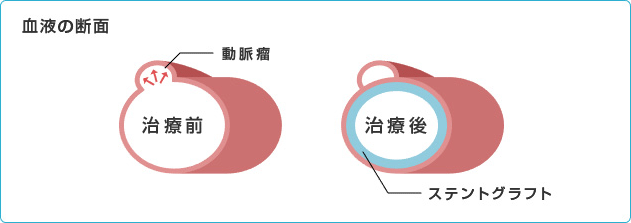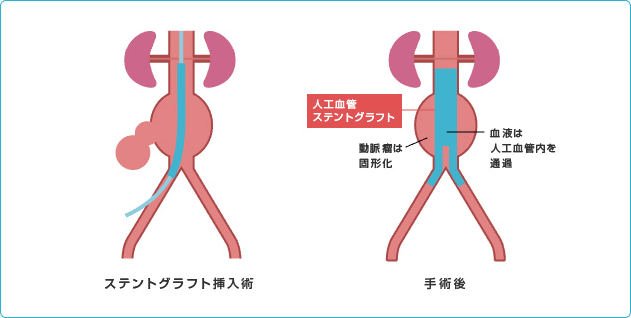

大動脈は、心臓から出て胸部と腹部にいたる、からだの中心を走る最も太い血管のことで、太さは胸部で直径約3cm、腹部でも約2cmもあります。
その太い血管で動脈硬化が進むと、血管内壁の弾力性が低下し、さまざまな異常が起こりやすくなります。
もろくなった血管内壁に高血圧などの要因が加わり、血管がコブのようにふくらんだ状態になるのが大動脈瘤。そして血管内壁の一部に亀裂が入り、剥離を起こした状態が大動脈解離です。

-

- ⼤動脈は⼼臓と全⾝を結ぶとても重要な⾎管です。この⼤動脈の病気の診断から治療までのすべてを、最新鋭の技術でお引き受けするのが「⼤動脈治療センター」です。早急な処置が必要な⼤動脈疾患に対し、診療科の枠を超えた専⾨チームにより、多様化する治療にあたっております。
-

- 心臓⾎管外科や⾎管外科の専⾨医をはじめ、看護師、⿇酔科医、診療放射線技師、臨床⼯学技⼠、臨床検査技師ら専⾨性の⾼いスタッフが結集したチームで治療にあたっています。外科的治療を専⾨とする⼼臓⾎管外科と、カテーテルなどを使った内科的治療を専⾨とする⾎管外科がタッグを組んで互いの技術を補完し合い、より⾼度な医療の提供をめざしています。さらに放射線治療部や救命救急センター、循環器科とも連携し、24時間365⽇体制で患者さんを受け⼊れております。
-

- ⼿術室と⾎管撮影装置を組み合わせた「ハイブリッド⼿術室」を横浜市で初めて完備し、カテーテルやステントグラフトを使⽤した⾎管内治療(内科的治療)から開腹・開胸の⼿術まで、さまざまな術式に対応できる環境を整えております。

⼤動脈疾患には緊急性の⾼いものが多いため、当センターでは24時間365⽇体制で治療にあたっています。胸や背中の痛みなどの⾃覚症状がなくても、⼤動脈瘤が⼤きくなっている場合があります。CTスキャンで簡単に検査することができますので、ご⼼配な⽅はお気軽に当センターへご相談ください。
⼼臓⾎管外科、⾎管外科、救急科など各科の専⾨スタッフが診療科の枠を超えて連携し、幅広い選択肢の中から患者さんの状況に合わせた治療を提供しています。従来の外科治療だけでなく、カテーテルを⽤いた新しい治療「ステントグラフト内挿術(※)」、ステントグラフトと外科⼿術を組み合わせた「ハイブリッド治療」などを導⼊し、患者さんの負担が少なく、5年先10年先まで⾒据えた治療法の確⽴をめざしています。
ステントグラフト内挿術とは
⼤動脈の⼀部が瘤(こぶ)のように膨らんでしまう病気を「⼤動脈瘤(だいどうみゃくりゅう)」といいます。⼤動脈瘤の治療では、瘤のある部位(胸部または腹部)を切開して⼈⼯⾎管を埋め込む外科⼿術が⼀般的ですが、最近では、外科⼿術が難しい患者さんに対し「ステントグラフト内挿術」という内科的治療が広がってきています。
ステントグラフト内挿術では、狭くなった⾎管を広げるための⾦属製の器具(ステント)を⼈⼯⾎管(グラフト)に組み合わせた「ステントグラフト」を使⽤します。脚の付け根から⾎管内に細い管(カテーテル)を挿⼊し、瘤のある部分までステントグラフトを運んで留置すると、広い範囲で⾎管が保護されて動脈瘤が破裂するリスクが軽減されます。切開するのはカテーテルを挿⼊する部分の4〜5cm程度だけで済むことから⾝体への負担が少なく、⼿術時間や社会復帰にかかる期間も短くなります。
当センターはステントグラフト実施認定施設です
当センターは、⽇本ステントグラフト実施基準管理委員会の定める、胸部⼤動脈ステントグラフト実施基準、および腹部⼤動脈瘤ステントグラフト実施基準による⾎管内治療の実施施設として認定されました。

 ⼼臓から全⾝へ⾎液を運ぶ⾎管を動脈といい、その中で最も太い⾎管を⼤動脈といいます。⼤動脈は⼼臓から⾝体の中⼼を通って腹部まで伸び、その先は⼿⾜の動脈に向かって枝分かれしています。⼤動脈の⼀部が瘤のように膨らんでしまう病気を「⼤動脈瘤」といい、その中でも胸部にできたものを「胸部⼤動脈瘤」といいます。
⼼臓から全⾝へ⾎液を運ぶ⾎管を動脈といい、その中で最も太い⾎管を⼤動脈といいます。⼤動脈は⼼臓から⾝体の中⼼を通って腹部まで伸び、その先は⼿⾜の動脈に向かって枝分かれしています。⼤動脈の⼀部が瘤のように膨らんでしまう病気を「⼤動脈瘤」といい、その中でも胸部にできたものを「胸部⼤動脈瘤」といいます。
瘤が⼩さいうちは定期的な診察を受け、お薬や⽣活習慣で増⼤を抑えていきますが、直径が4cmを超えると破裂する危険性が⾼まります。破裂して体内で⼤出⾎が起こると⼿術をしても救命することは困難なため、破裂を防ぐ治療が必要になります。
また、胸部⼤動脈瘤に対するステントグラフト内挿術を「TEVAR」と呼びます。TEVARでは、瘤の内側をステントグラフトと呼ばれる⼈⼯⾎管で覆うことで、瘤に⾎液が流れ込まないように遮断し、破裂を防ぎます。
 ⼤動脈瘤のうち、腹部にできたものを「腹部⼤動脈瘤」といいます。腹部動脈瘤は⼤きくなって破裂するまで症状がなく、破裂すると腰痛のような痛みが急激に激しくなり、やがて意識を失います。破裂は⼀旦起こると止まることはありません。
⼤動脈瘤のうち、腹部にできたものを「腹部⼤動脈瘤」といいます。腹部動脈瘤は⼤きくなって破裂するまで症状がなく、破裂すると腰痛のような痛みが急激に激しくなり、やがて意識を失います。破裂は⼀旦起こると止まることはありません。
腹部⼤動脈瘤に対するステントグラフト内挿術は「EVAR」と呼びます。胸部と腹部の⼤動脈は太さや形状、⾎管内の圧⼒などが⼤きく異なるため、前述のTEVARとは使⽤するステントグラフトの種類も異なります。
CT検査で腹部動脈瘤の破裂が確認されたときは、直ちに緊急EVAR⼿術を行います。短時間で破裂した部分にステントグラフトを留置して動脈瘤への⾎流を遮断し、破裂した動脈瘤からの出⾎を抑えます。
当院では横浜市内でいち早くこの治療法を導⼊し、これまで死亡例や重⼤な合併症もなく良好な成績を収めています。














